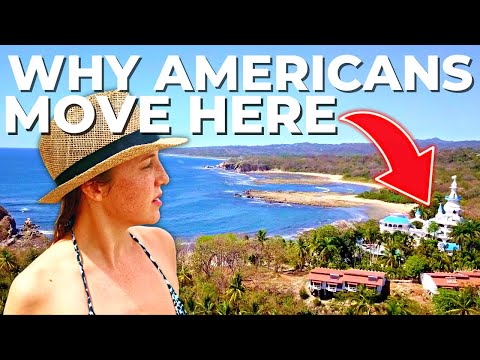Why So Many Americans Move to Nosara, Costa Rica

The beaches of Nosara are becoming somewhat like the places that Americans wanted to leave in the first place. How did a former cattle ranch that attracted hippies and surfers in the sixties and seventies become one of the most in demand places for Americans to live in Costa Rica today? Deep into the jungle of Costa Rica's Nicoya Peninsula lies a town that was once cut off from civilization by rivers on both sides. The only way in and out, especially during the rainy season, was by plain horse or oxcart. It's a town full of dust in the summer and rain and flooding in the winter. So what exactly does this tiny jungle village have to offer? Why are property prices here through the roof and why have thousands of foreigners moved there and how did this area become one of the oldest and most exclusive expat communities in Costa Rica? To answer these questions, we must start at the beginning.
Nos is located in the northwest Guanacaste province of Costa Rica, 240 kilometers from the capitol of San Jose, but it wasn't always part of the country of Costa Rica. The original inhabitants were the indigenous chro Tega natives, a group of people who lived in the region for more than 3000 years, farming the fertile land and fishing the surrounding waters. They were also skilled artisans whose clay pottery and designs still exist today in this small town of Gu in Costa Rica. The indigenous ch Ortega were eventually driven out of the area by Spanish conquerors in the early 15 hundreds who wreaked havoc on this tropical paradise. They stole the land, cleared out the dense primary forest for cattle pastures and sugar cane, and shipped thousands of Chorotega people to Peru and Panama to work in gold mines.
Although these Spanish invaders certainly had no knowledge of it at the time, this wild west mentality would survive and ultimately influenced the culture of this area first centuries to come. Although the ancestors of the Chorotega people and the Spaniards still live in Costa Rica today, their original homeland would never be the same and neither would the map of Costa Rica. You see on July 25th, 1824, Nosara became a part of Costa Rica during the annexation of Guana Coste when the political party of Nacoya left Nicaragua to join Costa Rica. Fast forward nearly 150 years, but still decades before the Costa Rican tourism and real estate boom of the early two thousands, and that's where our story resumes because in the early 1960s, an American businessman and surfer by the name of Alan Hutchinson ventured down to Costa Rica in search of perfect waves and a site to develop a residential community. During a private plane ride along the coast of the Nacoya Peninsula, he spotted the white sand beaches of what are now known as plys, guion and pada.
And after exploring the region even further on horseback, Alan knew he had found what he was looking for. His first impression of gion was that it was one of the finest beaches in the whole world, flat, smooth white sand and safe rolling surf. Whereas Pilate to the north is more whimsical. It's a secluded cove lined with palm trees, tidal pools, and hosts stunning sunsets. When Alan landed his plane on that nearby dirt airstrip, which is still the local Nosara airport today, that's where the story of modern day Nosara beacons. Alan was sold in between the years of 1969 to 1972.
He acquired a collection of cattle ranches that added up to some 890 hectares or 3000 acres in size. Then he got to work along with a group of local and international advisors. He devised his plan of the NO or American project, which is still thriving today.
The result of his vision was a detailed master plan that included 700 residential lots, wooded areas, parks, shopping centers, tennis courts, and an 18 hole golf course to attract buyers. Hutchinson advertised his master plan in American newspapers and publications, drawing some of the first investors through an ad in the New York Times at the time. For only a $100 refundable application fee would be investors could reserve a home site in the American project. A few years later, in 1975, the Nosara a civic association was formed by local landowners with three main objectives. First, to promote the maximum material and intellectual growth of all inhabitants of the area known as the Noosa beaches. Second,
to promote progress of the region without interference with the local culture. And third, to ensure the protection and conservation of the flora and fauna of the region, striving to maintain the natural ecological balance there. Although it seemed that Alan's new neighbors were on board with his vision, Alan wasn't able to deliver on his original promise leading the NCA members to take matters into their own hands. In 1976, a group of angry homeowners filed a lawsuit against Hutchinson in an attempt to force him to meet his contractual obligations of the development, all the while continuing to make payments to Hutchinson's offshore corporate bank account in the Cayman Islands. That same year,
Hutchinson and his family fled from Costa Rica to England, although the lawsuit wasn't settled until 1982. Now, although Allen Hutchinson is somewhat of a villain in our story, he wasn't all bad after all, he wanted to develop the land in nos a, in a responsible way, creating a paradise for people from abroad who were looking for a better and healthier lifestyle. And he wanted to do that in a way that discouraged mass tourism. So in a sense, residents ultimately did achieve that goal, although the future of NOS A is still at risk. More on that later, but Alan once wrote that the technological north is becoming less and less a place for an individual or family to return to Costa Rica with its green mountains and wide open spaces to our own beaches of Nosara what a joy it is.
In Nosara, there are cowboys and horses and wide beaches, and I stop and shake hands with everyone that is the local custom and these gentle peace-loving people are genuine and smilingly friendly. This can become your custom too. Alan wasn't wrong and his foresight, dedication and planning was way ahead of his time.
His master plan only included developing about one third of the total land area. 1200 acres were preserved as a forest and wildlife area, while another 1000 acres was dedicated for pastures and horseback riding. And although it didn't quite turn out that way, his initial vision and master plan combined with the lawsuit and settlement resulted in what is today known as the Bosque de Nosara a protected wildlife and nature preserve of 250 acres. That's still managed to this day by the Nosara a civic association You see, as a result of that lawsuit and settlement, homeowners finally received titles to their properties and a new company called Amigos de Nosara was formed to administer the additional assets, which included community water tanks, wells, parks, and electrical plant, landfill area, and those 250 acres set aside for wildlife preserve. Ever since the NCA has been fighting to protect the area from pollution over tourism and mass development. Without that lawsuit, the beaches of Nosara would look a lot different.
Today they say this video is brought to you by Prospera. Prospera is a governance platform that creates new cities via special economic zones, just like their flagship location in Roton Honduras. Now they're launching a revolutionary distributed network where members of their city builders network around the world can contribute to the development of NextGen cities. With Prospera, you can design the type of future and city you want to live in. Play a role in developing transportation systems. New ideas for energy crypto mortgages and more members of the community can also co-create with you.
It's a place to find both partners and investors. Prospera believes that when individuals have the freedom to build and govern for themselves, wages will rise, opportunities will multiply, communities will be safer, and a new social contract will be born. Find out more about joining Prospera or becoming an e resident at Prospera dot. Although there weren't and still aren't paved roads to the area. The first hotel Playas de Nosara was built in 1972, but it wasn't until 1979 that even a dirt road was built to connect the town of Nosara six kilometers inland with the beaches of Pilate and Gues. Nevertheless, in 1980, a second hotel, The Gilded Iguana, which still stands today, was built and since then, Nosara reputation and clout as a tourism destination has exploded. In fact, half a century after its inception,
the beaches of Nosara are unrecognizable for decades. Word about nos, a spread like wildfire, attracting people from around the world who were seeking good waves, an organic lifestyle and a better quality of life. Nosara has since become one of the world's top wellness meccas. After all, it's located in the Nacoya Peninsula, one of the world's only blue zones known for its high population of people who live to be 100 years old. It's also home to the Blue Spirit Yoga, meditation, and retreat center in Garza, a fishing village next door, and it's the original home of the NOS Ara Yoga Institute, bohi Tree Yoga Resort, and plenty of surf schools and plant medicine retreat centers.
In 2012 Nosara was rated one of the top 45 places to visit in the world by the New York Times. Yes, the same newspaper where the American Project AD first appeared in the early 1970s. In 2014, it was ranked one of CNN's top 11 places to go in the world, and in 2017, it was named the fastest growing surf town in the world by economists at the University of Sydney in Australia with Playas Nosara and Guiones ranking first and seventh in the world for propensity for a coastal real estate explosion. And in 2023, a parcel of land that once cost $3,000 in the beaches of Nosara is now upwards of a million dollars or more.
Meanwhile, the US has become Costa Rica's main source of tourists attracting 1.25 million US citizens in the last year, far from rolling hills of empty cattle pastures. What is the Nosara of today like? Well, it still takes five or six hours to drive there from the Capitol of San Jose or two and a half hours from the nearby at Liberia Airport. You can also fly into the local Nosara airport which offers flights from local airlines such as Sansa and Nature Air, and once you arrive, rather than riding around on horseback, although that is still a thing most people get around by motorbike, golf cart, ATV, or S U V. Those once pristine empty beaches are still beautiful, but now often crowded with umbrellas, lounge chairs, yogis, artisans, retirees, and plenty of pets and stray dogs. The empty sugar cane fields and rolling cattle pasture are studded with luxury homes and hotels, yoga and Pilate Studios, bars, restaurants, and more. There are gas stations, banks,
convenience stores, grocery stores, doctors, dentists, and two international schools. And of course, there are plenty of real estate offices to meet the demand of thousands of foreign investors, primarily from the US, Canada, and Europe. The last Costa Rican census in 2011 estimated the population in the town of Nosara to be less than 5,000 people, but today there could be just as many foreigners living in the surrounding beaches. This stark geographical division between the locals living inland and the wealthy expats on the coastline is impossible to ignore.
And although there is a relative peace and harmony between the local and expat community, it's not without its problems intentions. Some of the most pressing issues facing the area today include problems with crime and water. You have water contamination from construction and water shortages from drought, overdevelopment, and earthquakes. The province of Guana Coste also has a longer dry season than other parts of the country, and the water level in Nosara reportedly hasn't recovered since suffering a 7.6 magnitude earthquake in 2012. This fragile balance between the environment and population growth is also at risk. According to a nos,
a civic association changed.org petition from 2017 to 2018, there was a 42% increase in construction in Nosara There's also scientific evidence of salinization of the aquifers due to the large number of construction projects in the first 600 meters of the coastline of the Guione North sector says the N C A President Luis Parto. The challenge of coexisting with the fragile wildlife and its habitat cannot be taken lightly. Relying on the authorities to react as fast as private investments or waiting for someone to do something about it is unrealistic. Members of the nearby town of Sam's Chamber of Tourism agree, Costa Rica doesn't have the resources, funds or infrastructure to address the issues that accompany tourism growth in the Nacoya area. They say until recently,
trash collection was also a problem with most local trash languishing and an open air landfill and no recycling. But after 10 years of lobbying efforts, the Nacoya municipality is finally picking up the trash rather than leaving it there. Outside local Ticos have also been affected by these problems and more.
They've suffered a drastic increase in their cost of living due to the rapid development and also higher competition for local jobs from other Costa Ricans around the country today. There's a clear division among the local residents. You have the locals who are born in Nosara, the Costa Ricans from outside the area who come looking for work, and then the foreign international residence in the area. This tension has resulted in an increase in petty theft as well as violent crime, including home invasions and murders in the Nosara area many houses are now designed by architects specifically to prevent theft while others have security guards, bars and cameras monitoring the houses 24 7, although crime still happens, there's also some resentment among locals that most businesses are owned by Americans and Europeans said one local worker in a private interview. The issue of work in Nosara is very particular. There's discontent of people who, like me, have training and activities very typical of Nosara but there is that invisible wall, that topic that is not discussed either.
Finally, everyone is also a victim of health problems that arise from the dust that's stirred up during the dry season on those unpaved roads, which today are filled with traffic and construction work and an ironic turn of events. The beaches of Nosara are becoming somewhat like the places that Americans wanted to leave in the first place. Uh, just a typical day in Nosara. We have a pig in the back of a truck. We have a traffic jam, we have road work going on. We have every type of vehicle, trucks, buses, four wheelers, whatever this is. But fortunately there are solutions. For one.
The NCA has done a great job of maintaining the original vision of the Nosara American project among the many initiatives they've taken on over the years. One recently includes submitting a building regulation bill that seeks to create a buffer zone with the Osteo Now Wildlife Refuge. This bill aims to ensure the sustainable use of aquifers, estuaries, and mangroves up to one kilometer out into the sea.
It would also install building height restrictions and light restrictions designed to protect the upwards of 180,000 sea turtles who hatch in the area. Each year. The NCA also cleans, protects and maintains 250 acres of wildlife reserve, which have captured 250 tons of carbon from the air. They also build roads, roundabouts, sidewalks, and walking trails, and they plan to convert that old landfill into a public nature park.
The problem is they need more members. Membership has barely grown at all since it was formed in 1975, but fortunately anyone can help. You can donate to the NCA's cause@nca.cr and find more resources for how to help. In this video's description, a volunteer association called Asada was also formed to distribute and ration water.
You can join their cause@pdnasada.com or get more info on Nosara.com. And also there is a silver lining to development in this area compared to the rest of Costa Rica. Development in Nosara has been notably slower, more sustainable, and less disruptive comparatively to the environment and its wildlife. After all,
Costa Rica is known as a green country with a commitment to sustainability and the area's growing. Popularity has also stimulated the local economy, creating many jobs and providing opportunities to local entrepreneurs and small business owners. One local blogger says that the general consensus in town is that most people who've settled in Costa Rica for the long haul agree that the varied and diverse culture is part of what makes the country so great. The welcome anything goes approach affords a lot of chances to meet new people and learn about other cultures.
As a former international resident of Nosara myself, between 2005 to 2008, I've personally witnessed the beauty and struggles of this unique community firsthand and looking forward. I agree that the best way to protect Nosara is to raise awareness as well as solutions. Fellow international residents should make it a priority to understand the history of Nosara, how it was formed, and get informed about issues.
They should also financially support causes and organizations such as the NCA and Asada, hire locals and pay them fair wages and do their best to integrate with the local community. That means learning Spanish, attending community meetings, and getting involved as much as possible. As the NCA says, the magic of Nosara is no accident. It's been a vision in development since 1975, and the executive director says that after nearly 50 years of existence, the NCA has a tremendous legacy in this community. Their priority is to reconnect the growing town to the NCA's vision of creating a model community that values the wellbeing of people and all living beings. That's something that would hopefully make the Chor Ortegas proud and honor their legacy as their ancestors still reside in Costa Rica today.
It's also something that Alan and his first international neighbors likely intended and clearly has also remained a priority for local ticos. Again, you can contribute to the NCA and help protect the future of Nosara at nca.cr because Nosara Somos, no Soros. What do you love about Nosara? How can we best protect it in the future? Let us know your opinions and the comments below, and share this video with those who love Nosara too.
2023-03-08 22:25


